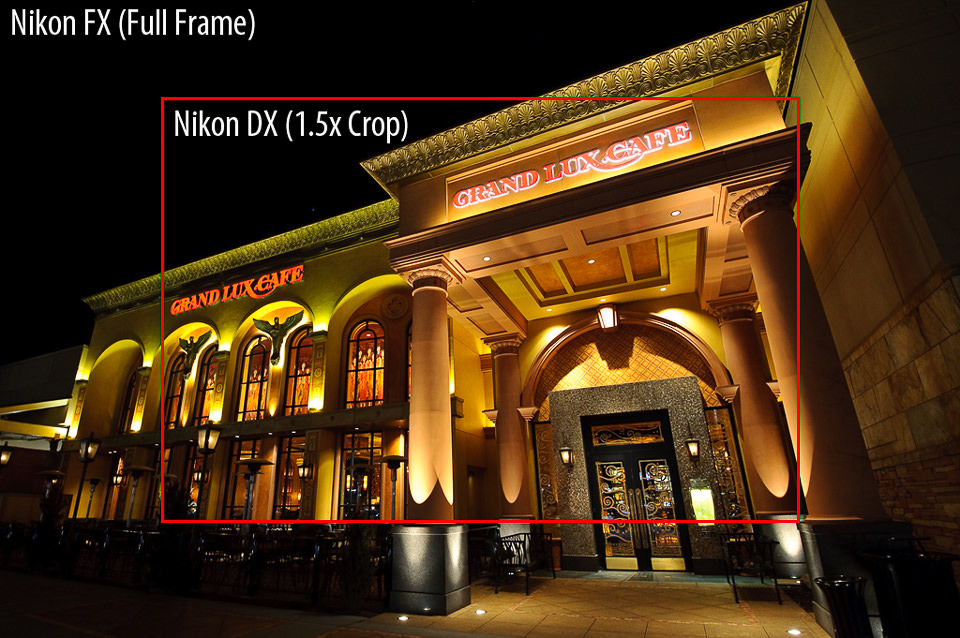Nuffnang skali...
Saturday, December 22, 2012
Monday, October 1, 2012
Sunday, September 23, 2012
Sunday, August 26, 2012
Monday, August 6, 2012
Friday, July 6, 2012
Monday, June 18, 2012
Nikon DX vs FX
Some of the most frequently asked questions from our readers are around DX and FX format sensors. What is DX and FX? What are their differences? Which one is better and why? If you have similar questions and want to get a clear understanding about these formats and their differences, along with seeing actual image samples from both, this article is for you.
Before diving into sensor formats, it is first important to understand what a sensor is and what it does in a Digital SLR camera. It is easier to understand how sensors work by comparing them with the human eye. The lens in front of the camera essentially functions as the cornea of your eyes, gathering ambient light and passing it to the iris. The iris then expands or shrinks, controlling the amount of light that enters the retina, which functions almost exactly like a camera sensor. The retina is light-sensitive, meaning it can adjust its sensitivity based on the available light. If there is too much light, it decreases its sensitivity, while automatically increasing the sensitivity in a dim environment, so that you could see in both extremely bright and extremely dark conditions. Remember what happens when you come out of a dark place to a very bright, sunny environment and vice-versa? Either your eyes will hurt and everything will seem too bright, or you will have a hard time seeing at all – due to sensitivity of the eyes that have not yet adjusted for the new environment. The sensitivity of your eyes is just like the sensitivity of the sensor, also known as “ISO” in photography. But sensitivity comes at a price – high sensitivity levels ultimately decrease image quality, similar to when you have a hard time seeing in a very dark environment. This degradation of image quality is first visible as “grain” or “noise” in the pictures, followed by loss of detail, sharpness and color in extreme levels of sensitivity. When I say “extreme”, I mean extreme to the digital camera, not human eye. Even with all of the latest advancements in sensor technology, cameras are not even close to seeing the range of light the human eye can see in various environments.
WHAT IS DX?
When Nikon entered the digital world of SLR photography, their first Nikon D1 DSLR had a smaller sensor to make it more accessible to professionals (it sold for $5,850 when it was announced). It was about 2/3 of the size of the 35mm film and it only had 2.66 megapixels. The camera quickly gained popularity and more updates of the same DSLR followed – some with more resolution and others with more speed. Nikon eventually dubbed the smaller sensor “DX”, which is approximately 24x16mm in size and is still being widely used in all entry-level (Nikon D3000/D5000), semi-professional (Nikon D90) and even professional (Nikon D300s) cameras. Obviously, the number of megapixels went up significantly with the latest DX sensors having 12.3 effective megapixels (4,288 x 2,848 resolution), which means the pixel size has also equally decreased, resulting in higher pixel density. Nikon has been able to do so because of new advancements in sensor technology, better noise-reduction algorithms and more processing power.
Historically, all digital sensor formats have been measured and compared against 35mm film. In the case of DX format, due to the sensor being smaller than 36x24mm (size of 35mm film), the subjects appeared slightly more magnified when compared to film. This was normal for the DX format, because smaller sensor meant that a smaller area of the lens towards the center was to be used and everything else discarded. However, photographers kept on comparing this difference in field of view or angle of view to the traditional film and new terms such as “crop factor” and “equivalent focal length” were born. Why did this happen? Because a photographer with a DX digital camera using a 50mm lens appeared to have the same view as a film photographer with a 75mm lens and nobody wanted to accept this change as “normal”, again, relative to film.

Nikon DX sensors, for example, have a crop factor of 1.5x. What this means, is that relative to 35mm film, the image will appear enlarged by approximately 50%. So shooting with a 24-70mm lens is “equivalent” of shooting with a 36-105mm lens on a film body. This is where things got messy and people started getting confused about focal lengths and sensor sizes. How can you say that a lens is longer in focal length with a DX sensor, if the physical property of the lens has not changed? A 24-70mm lens is a 24-70mm lens no matter which camera body it is on and no sensor can change that. The whole “equivalent to mm” verbiage can be too confusing, because it is equivalent only relative to 35mm film. At the same time, how do you explain that a 200mm lens on a DX sensor has an equivalent field of view of a 300mm lens on film? That’s why it has been quite common among photographers to compare this new field of view problem with film.
WHAT IS FX?
In August of 2007, Nikon released the long awaited full-frame Nikon D3 FX camera with 12.1 megapixels. It was the first Nikon DSLR to have a 35mm equivalent digital sensor that measured approximately 36x24mm in size with a 4256×2832 resolution. Nikon realized that cramming more pixels into a tiny DX sensor was not helping in low-light situations and the only way to increase the sensitivity of the sensor was to increase the pixel size. The 36x24mm full-frame sensor is more than twice larger in size than a 24x16mm DX sensor. By keeping the number of megapixels low relative to the size of the sensor, Nikon increased the pixel size by 2.4 times, thus having much larger photosites to store light particles. What this meant, was that the sensor could have higher sensitivity levels and see a much larger range of light from blacks to whites, known as “dynamic range“.
With the full-frame FX sensor, the terms “crop factor” and “equivalent focal length” are no longer valid, because an FX sensor is the same size as film. This means that if you took a film camera and a full-frame digital camera, mounted 24-70mm lenses on them and took pictures of the same subject, both would produce a similar view, not a magnified one like with DX sensors.
For more info, please visit mansurovs.com
AF-S DX Nikkor 18-300mm F3.5-5.6G ED VR
Nikon launches AF-S DX Nikkor 18-300mm F3.5-5.6G ED VR superzoom lens
Nikon has launched the AF-S Nikkor 18-300mm F3.5-5.6G ED VR lens, a 16.7x superzoom for APS-C DSLRs. The 18-300mm offers the highest ever zoom ratio for a Nikon interchangeable lens, giving a 27-450mm equivalent range on one of the company's DX-format cameras. The lens is a much more complex design than the existing 18-200mm - utilizing 19 elements in 14 groups and, at 120mm long, is 23% longer. It features a 77mm filter thread and will be available from June 2012 at a price of around $999.
MELVILLE, N.Y. (June 14, 2012) – Today, Nikon Inc. announced the addition of two new lenses to the legendary NIKKOR lineup, the AF-S DX NIKKOR 18-300mm f/3.5-5.6G ED VR and the AF-S NIKKOR 24-85mm f/3.5-4.5G ED VR lenses. The new 18-300mm VR lens is a versatile and compact 16.7X all-in-one super zoom DX-format lens, while the new 24-85mm VR lens is an ideal standard zoom for any FX-format photographer. These optics were designed to meet the needs of all types of photographers, from those looking to capture everything from family outings to elusive wildlife and stunning landscapes. The new 18-300mm and 24-85mm lenses deliver the performance and superior image quality that photographers of all levels have come to expect from NIKKOR lenses whether capturing still images or HD videos.
To capture stunningly sharp images with excellent clarity and color reproduction or HD video that exhibits sharp critical focus with a dramatic depth of field, the new 18-300mm VR and 24-85mm VR lenses will empower photographers with a variety of exclusive core NIKKOR technologies. Both lenses are equipped with Nikon’s Vibration Reduction (VR) II image stabilization system which provides the equivalent of a shutter speed approximately four stops faster. The built-in Vibration Reduction will help photographers create blur-free images and video while shooting handheld and in challenging lighting conditions. Two focus modes, manual-priority autofocus (M/A) and manual focus (M), are easily selected in both lenses as well. When either lens is in manual-priority autofocus (M/A) mode, users will be able to instantly switch from autofocus to manual focus operation by simply rotating the focus ring, even during AF servo operation. Additionally, both lenses feature an internal focusing system, providing fast focus without changing the length of the lens while retaining working distance through the focus range, and Nikon’s Silent Wave Motor (SWM) technology designed to deliver fast, accurate and quiet AF performance. The lenses also boast Nikon’s Super Integrated Coating (SIC) which provides superb color reproduction, color consistency and reduced flaring.
“Whether a pro on assignment, a photo enthusiast or an indie cinematographer, all Nikon users appreciate and rely on the vast selection and reliability of NIKKOR lenses for all of their imaging needs,” said Bo Kajiwara, director of marketing, Nikon Inc. “The new AF-S DX NIKKOR 18-300mm VR and AF-S
NIKKOR 24-85mm VR lenses are fully optimized to capture stunning images and videos while meeting the growing needs of photographers of all levels around the world.”
NIKKOR 24-85mm VR lenses are fully optimized to capture stunning images and videos while meeting the growing needs of photographers of all levels around the world.”
More info at dPreview.com
Nikon announces AF-S Nikkor 24-85mm F3.5-4.5G ED VR
Nikon has announced the AF-S Nikkor 24-85mm F3.5-4.5G ED VR, a comparatively affordable, stabilized, variable aperture standard zoom lens for full frame cameras. It comes as Nikon celebrates the sale of the 70 millionth Nikkor lens since 1933, and the 30 millionth silent-wave motor lens since the system's introduction in 1996. It's hard not to interpret the announcement as lending weight to the rumors of an affordable full-frame body, since it's hard to imagine large numbers of D800 owners using such a lens (with its recommended price of $599) as their everyday lens.
MELVILLE, N.Y. (June 14, 2012) – Today, Nikon Inc. announced the addition of two new lenses to the legendary NIKKOR lineup, the AF-S DX NIKKOR 18-300mm f/3.5-5.6G ED VR and the AF-S NIKKOR 24-85mm f/3.5-4.5G ED VR lenses. The new 18-300mm VR lens is a versatile and compact 16.7X all-in-one super zoom DX-format lens, while the new 24-85mm VR lens is an ideal standard zoom for any FX-format photographer. These optics were designed to meet the needs of all types of photographers, from those looking to capture everything from family outings to elusive wildlife and stunning landscapes. The new 18-300mm and 24-85mm lenses deliver the performance and superior image quality that photographers of all levels have come to expect from NIKKOR lenses whether capturing still images or HD videos.
To capture stunningly sharp images with excellent clarity and color reproduction or HD video that exhibits sharp critical focus with a dramatic depth of field, the new 18-300mm VR and 24-85mm VR lenses will empower photographers with a variety of exclusive core NIKKOR technologies. Both lenses are equipped with Nikon’s Vibration Reduction (VR) II image stabilization system which provides the equivalent of a shutter speed approximately four stops faster. The built-in Vibration Reduction will help photographers create blur-free images and video while shooting handheld and in challenging lighting conditions. Two focus modes, manual-priority autofocus (M/A) and manual focus (M), are easily selected in both lenses as well. When either lens is in manual-priority autofocus (M/A) mode, users will be able to instantly switch from autofocus to manual focus operation by simply rotating the focus ring, even during AF servo operation. Additionally, both lenses feature an internal focusing system, providing fast focus without changing the length of the lens while retaining working distance through the focus range, and Nikon’s Silent Wave Motor (SWM) technology designed to deliver fast, accurate and quiet AF performance. The lenses also boast Nikon’s Super Integrated Coating (SIC) which provides superb color reproduction, color consistency and reduced flaring.
“Whether a pro on assignment, a photo enthusiast or an indie cinematographer, all Nikon users appreciate and rely on the vast selection and reliability of NIKKOR lenses for all of their imaging needs,” said Bo Kajiwara, director of marketing, Nikon Inc. “The new AF-S DX NIKKOR 18-300mm VR and AF-S
NIKKOR 24-85mm VR lenses are fully optimized to capture stunning images and videos while meeting the growing needs of photographers of all levels around the world.”
NIKKOR 24-85mm VR lenses are fully optimized to capture stunning images and videos while meeting the growing needs of photographers of all levels around the world.”
More info in dPreview.com
Sigma 18-250mm F3.5-6.3 DC Macro OS HSM Annouced
Sigma has announced a compact 18-250mm F3.5-6.3 'Macro' superzoom lens for APS-C DSLRs. The latest version is an entirely new design, smaller than the existing lens and incorporating 'Thermally Stable Composite' (TSC) construction. TSC is a material currently used exclusively by Sigma, designed to minimize barrel expansion or contraction with extreme temperature variation. The lens will be available from July, starting with the Canon-mount version, with Nikon, Sony, Pentax and Sigma to follow.
Ronkonkoma, NY, June 15, 2012 - Sigma Corporation of America, a leading researcher, developer, manufacturer and service provider of some of the world's most impressive lines of lenses, cameras andflashes, is pleased to announce the availability of its new Sigma 18-250mm F3.5-6.3 DC Macro OS HSM lens starting in July 2012. Pricing is still pending.
The addition of the 18-250mm F3.5-6.3 DC Macro OS HSM speaks to Sigma's versatile product lineup with this multipurpose zoom lens that offers Optical Stabilization (OS)* and covers wide angle to telephoto to macro photography. It differs from Sigma's current 18-250mm F3.5-6.3 DC OS HSM lens with its even more compact size, its macro capability with a maximum magnification ratio of 1:2.9 and the use of Thermally Stable Composite (TSC) material currently used only by Sigma.
TSC, which is incorporated into the lens barrel and is often compared to polycarbonate, has a high degree of elasticity and exhibits little variation in its structure in extreme temperature conditions. This means that internal barrel expansion and contraction due to extreme temperature variations is less prevalent. TSC also contributes to the lens' size reduction. The non-macro 18-250mm F3.5-6.3 without TSC weighs 22.2 ounces and is 3.1 by 4 inches in diameter, whereas the new macro lens is 16.6 ounces and 2.9 by 3.5 inches in diameter.
"We're constantly trying to improve and expand our lens lineup, and this addition is no exception," said Mark Amir-Hamzeh, president of Sigma Corporation of America. "By redesigning the lens and adding TSC, we are able to offer this very compact, feature-rich lens that is flexible enough to tackle a range of photography, including landscape, sport and macro. This is key for the everyday photographer who wants to travel light but pack the punch of a complete camera bag."
Sigma optimized this lens' power arrangement by incorporating double-sided aspherical lenses and reexamining the design to achieve a more compact filter diameter. The lens has an approximate 13x high zoom ratio with a filter size of 2.8 inches in diameter. Sigma's unique OS system, as well as one Special Low Dispersion (SLD) glass and three aspherical lens glasses, compensate for camera shake and enable correction of color aberration, respectively.
The new 18-250mm F3.5-6.3 DC Macro OS HSM lens is also equipped with Super Multi-Layer Coating to reduce flare and ghosting, a Hyper Sonic Motor (HSM) to ensure fast and quiet auto-focusing, and a rounded, seven-blade diaphragm to create an attractive round blur to the out of focus areas. The lens features a brass-made bayonet mount applied on the surface to reinforce strength for long-term use and enable high accuracy and solidity.
This lens will be available in Sigma, Sony, Nikon, Canon and Pentax mounts, starting with Canon mounts coming in July, 2012. Pricing and all availability for other mounts have yet to be announced.
To locate an authorized Sigma dealer nearest to you, visit http://www.sigmaphoto.com/where-to-buy-sigma. For information about Sigma Corporation of America, visit www.sigmaphoto.com.
Source dPreview
Sunday, June 17, 2012
Subscribe to:
Comments (Atom)

















































